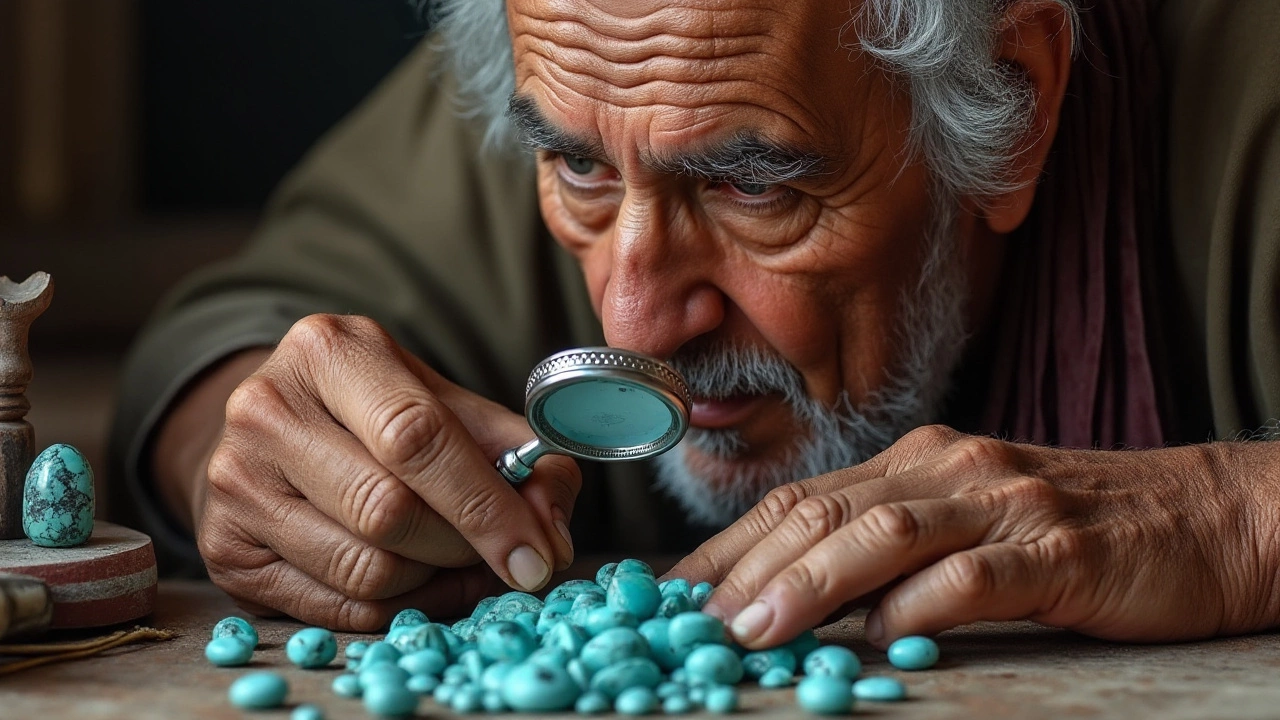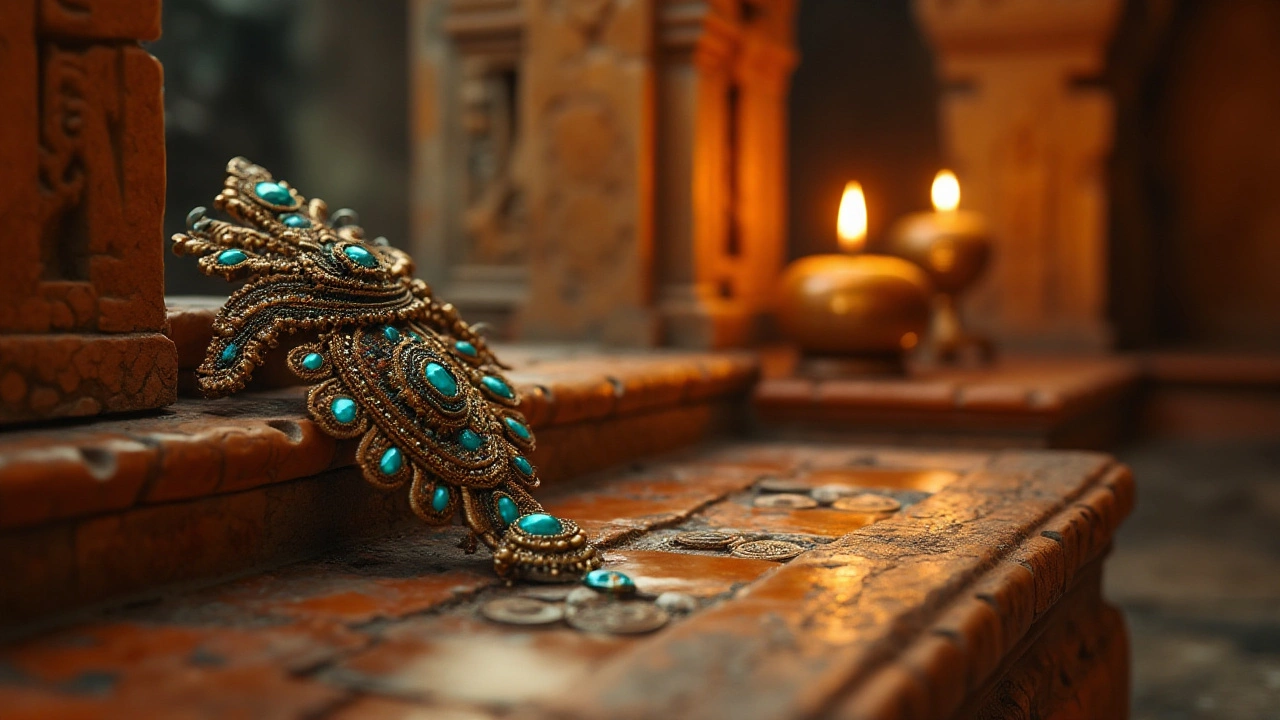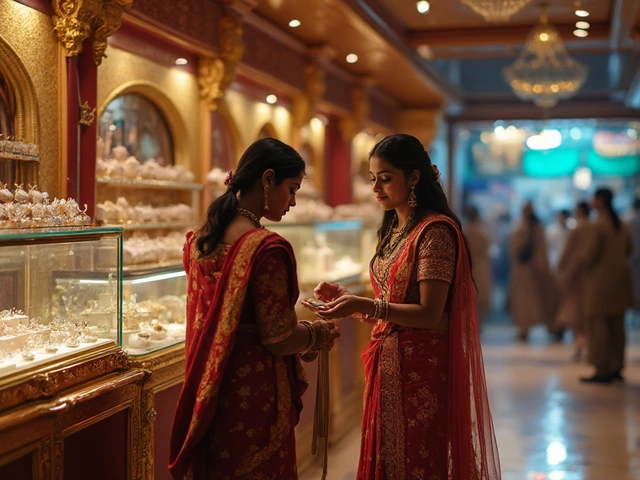Turquoise, with its striking blue-green allure, holds a cherished place in the world of temple jewellery in India. This gemstone, steeped in history and cultural significance, often finds itself at the center of both fascination and controversy. Why controversy? The market is awash with imitations, making it essential for jewellery enthusiasts to equip themselves with the knowledge to discern the real from the fake.
In this guide, we will explore the unique characteristics of turquoise, discuss common types of imitations, and walk you through the methods to test its authenticity. Whether you are a collector, a seller, or just someone enchanted by the beauty of turquoise, these insights will prove invaluable in your quest for genuine pieces.
- Historical and Cultural Significance
- Physical Characteristics of Turquoise
- Common Types of Imitation Turquoise
- Testing Methods to Verify Authenticity
- Tips for Buying Genuine Turquoise Jewellery
Historical and Cultural Significance
Turquoise has long been revered for its captivating beauty and rich cultural meanings across various civilizations. In the context of India, the gemstone became particularly significant in temple jewellery, symbolizing spiritual protection and divine connection. The use of turquoise in temple embellishments has been seen as a tribute to deities, merging the earthly with the heavenly through its vibrant hues. This tradition is believed to have roots as old as the Indus Valley Civilization, where the significance of stones in religious rituals was well documented.
The vibrant color of turquoise is often associated with water and the sky, elements essential for life. Its representation as a stone of healing and tranquility is echoed in numerous historical records, where it was used to adorn the sacred spaces of temples in various regions of India. Historians suggest that during the reign of the Mughal Empire, turquoise was highly valued for its protective qualities and regal allure, often being integrated into royal crowns and amulets. This tradition is mirrored in temple arts, where artisans crafted intricate patterns incorporating turquoise to not only display wealth but also to invoke blessings and positive energy.
In more recent times, the use of turquoise in temple jewellery has persisted, reflecting the stone's continuing significance in Indian culture. As noted by scholars, its presence is often more than decorative; it embodies a link to historical craftsmanship and spiritual lore that still captures the imagination today. Artisans meticulously polish and set each piece, aiming to preserve historical techniques while catering to modern tastes. It represents an enduring legacy that transcends fashion, holding a place in both ancestral stories and contemporary designs.
"Turquoise is not merely a stone, but rather a bridge between man and myth, capturing the imagination with its celestial allure. In temple jewellery, this gemstone stands as a testament to the cultural tapestry woven by our ancestors," as noted by renowned gemologist Ratna Sharma.
The continued use and reverence of genuine turquoise highlight its revered status and dynamic role through the ages. Whether embraced by royalty or ordinary devotees, its enduring appeal is a reminder of turquoise's multifaceted significance—blending protection, aesthetics, and history into every piece of temple jewellery. It beckons us not just to admire its beauty but to delve into the stories and traditions it carries, echoing the sentiments of communities who have cherished this gem across millennia.
Physical Characteristics of Turquoise
Understanding the physical characteristics of turquoise is essential for anyone hoping to differentiate between authentic gemstones and their myriad imitations. Known for its vibrant blue to green hues, turquoise captivates not only through its color but also through its texture and luster. Typically, genuine turquoise features a matrix—distinctive veined patterns running through the stone, often referred to as the stone's fingerprint. The matrix can vary in color from dark brown to a golden hue, depending on the minerals embedded within. This unique trait adds to turquoise's allure, particularly in temple jewellery crafted in India.
Turquoise's color is influenced by its copper and iron content, with copper lending the mesmerizing blue shades and iron contributing to the greens. A fascinating fact is that some of the best-quality turquoise comes from Iran, often called "Persian Turquoise," known for its intense, consistent color and minimal matrix. This contrasts with American turquoise, which frequently displays a more noticeable matrix, making it desirable for those who appreciate character and uniqueness in gemstones.
The gemstone's texture is equally revealing. Authentic turquoise feels smooth and waxy to the touch, a contrast to the gritty or overly polished sensation fake stones might exhibit. High-quality, natural turquoise can vary in hardness but generally scores between 5 to 6 on the Mohs scale. This means it's reasonably durable but not as hard-hitting as sapphires or diamonds, making it ideal for intricate jewellery designs without compromising its integrity.
"Turquoise is a gemstone that has transcended time, adored since ancient civilizations. Its unique qualities make it not just a stone, but a piece of history," says Gemological Institute of America.
One must also consider the stone's density. Turquoise is a porous stone, meaning it's susceptible to changes in color and performance over time due to exposure to oils or environmental factors. This porosity is a double-edged sword, granting it an innate charm while requiring careful handling. Be cautious as enhanced or stabilized turquoise might lack this porosity, making them less prone to changes but simultaneously less valuable. When purchasing turquoise in temple jewellery, keep an eye out for color consistency and texture that feel naturally integrated rather than synthetic or overly saturated.
Interestingly, the weight of turquoise can be a telltale sign of its authenticity. Genuine turquoise is relatively lightweight. If a piece feels unnaturally heavy, it might be helped along with a polymer to enhance its stability and look, a practice not uncommon in the craft of imitation or lower-grade stones. However, such treatments are often detected by experienced artisans and collectors who have developed a keen sense for spotting the genuine article. Therefore, familiarizing yourself with these nuances can ensure that your purchase truly embodies the rich history and splendor associated with turquoise in temple jewellery.

Common Types of Imitation Turquoise
In the ever-evolving world of jewelry, imitation stones have woven a complex web of deceit and fascination. Among these, imitation turquoise holds a prominent place, often leaving both casual buyers and seasoned collectors puzzled over authenticity. Understanding the landscape of fake turquoise is crucial to making informed purchases and appreciating the true value of this stunning stone. The first contender in the world of turquoise imposters is dyed howlite. Howlite naturally appears in a whitish color, often adorned with gray veining. However, when subjected to dyeing, it can mimic the bluish shades of turquoise with surprising similarity. Though visually convincing, dyed howlite lacks the vibrancy and unique patterning found in genuine turquoise.
Another prevalent imitation is reconstituted turquoise. This material is essentially a mixture of turquoise scraps, dust, and binding agents, which are molded and hardened to create stones that appear quite similar to their natural counterparts. While these pieces can include small amounts of real turquoise, they are not categorically 'pure', and often exhibit an unnaturally vibrant color due to the dyes used in the process. A more sophisticated form of imitation is the creation of synthetic turquoise, cultivated in laboratories to mimic the stone in composition and structure. While synthetic versions are chemically identical to the natural stone, they often feature an overly uniform appearance, lacking the organic variation in color and pattern that makes natural turquoise unique.
A notable mention goes to the various resin and plastic imitations, often marketed under vague names. These are typically more affordable and can quite easily be spotted due to their lightweight and glossy surface. Yet, sellers may try passing them off as natural turquoise to the untrained eye. Varnished or coated stones also come into play in the realm of turquoise imitation. These stones often have a thin layer of translucent resin or wax applied to give them the appearance of depth and luster similar to genuine turquoise. Ask any gem enthusiast, and they might tell you: "The devil is in the details," capturing the nuanced challenge of distinguishing real from imitation.
Yet, armed with the right knowledge, identifying these substitutes becomes a rewarding pursuit. Carefully observing the stone's pattern, weight, and the price point can provide initial clues. Additionally, a scratch test or magnified inspection can reveal signs of dye or composite material. Always remember, a trustworthy seller is open about their products, eliminating the need for suspicion. These insights illuminate the various forms of imitation turquoise circulating in the market, providing a beacon of guidance for anyone enthralled by the captivating beauty of this ancient stone. Thus, as you embark on your quest for genuine temple jewellery adorned with turquoise, may you find more clarity and confidence in choosing pieces that carry the true spirit and beauty of this gemstone.
Testing Methods to Verify Authenticity
The allure of turquoise in temple jewellery is undeniable, yet with its growing popularity comes the challenge of identifying genuine stones amidst a sea of imitations. Fortunately, there are several testing methods that can help you ascertain the authenticity of turquoise gemstones, ensuring that your cherished pieces are truly authentic. Understanding these methods is critical for anyone with an interest in collecting or purchasing this precious stone.
One practical approach is the visual inspection method. Genuine turquoise typically exhibits a unique matrix, which is the web-like pattern formed by the surrounding host rock. This matrix can vary greatly from stone to stone and is an important indicator of authenticity. When examining a piece, look for irregular patterns and variations in color that are difficult to replicate with synthetic materials. This method, although requiring a discerning eye, can effectively distinguish between real and fake if studied carefully.
For those keen on more scientific methods, the scratch test can be particularly telling. Turquoise is a relatively soft stone, ranking between 5 and 6 on the Mohs hardness scale. By gently applying a sharp object, such as a needle, you can verify its softness. However, be cautious with this test to avoid damaging the stone. Authentic turquoise should not scratch easily under minimal pressure, whereas many substitutes and fakes will show scratches more readily, indicating a lower hardness level.
A more modern approach involves using a small magnet. Authentic turquoise is generally not magnetic, so a simple test involves bringing a small magnet close to the stone. If there is any attraction, it might indicate the presence of materials that are not genuine turquoise. This test, while not wholly conclusive, is an easy and nonintrusive way to gauge authenticity.
Water immersion tests can also be revealing. When placed in water, genuine turquoise will not absorb or change its composition. In contrast, many imitations may absorb water, leading to color changes, as they use dyed materials to replicate turquoise's vivid hues. This test is simple and can frequently provide a quick indication of the stone's authenticity.
"The truth of the gemstone lies in its response to the very elements it once formed from." - An eminent gemologist once noted.
For those seeking absolute certainty, professional testing using advanced equipment, such as spectroscopy, can conclusively identify genuine turquoise. While this method requires specialized resources, it provides definitive results. Access to such advanced techniques, however, may not always be practical for the casual buyer, highlighting the importance of consumer knowledge and awareness.
By understanding and implementing these various testing techniques, buyers and enthusiasts alike can better navigate the growing market of turquoise in India. These methods not only ensure that one receives the genuine article but also contribute to a deeper appreciation of the authenticity and uniqueness of this captivating gemstone.

Tips for Buying Genuine Turquoise Jewellery
When it comes to purchasing turquoise jewellery, especially within the context of temple jewellery in India, being equipped with the right knowledge is crucial. The market is a vibrant expanse filled with both authentic gems and clever look-alikes, making the task of distinguishing the two a bit of a treasure hunt. One of the simplest yet most overlooked tips is to purchase from reputable sources. Trusted dealers often provide authenticity certificates, ensuring that you're getting the real deal. It's always a good idea to seek recommendations or check customer reviews to build confidence in your choice of seller.
Understanding the physical attributes of real turquoise can significantly tip the scales in your favor. Genuine turquoise is often characterized by a porous and matte surface, although some pieces may be polished to enhance their vibrancy. Familiarize yourself with the stone's natural variegations and inclusions, which add to its charm rather than detracting. A popular tip from connoisseurs is to subtly touch the stone to your tongue. Authentic turquoise will feel slightly adhesive owing to its porous nature, unlike the smooth feel of faux varieties.
"Turquoise is a stone that carries deep cultural resonance, and thus verifying its authenticity is a step towards preserving its heritage," remarks Dr. Aarthi Rawal, a renowned gemologist specializing in Indian gemstones.
Pioneering tests such as the hot needle test may sound daunting, but they are rooted in simplicity. If a needle heated over a flame is gently pressed against the stone, real turquoise will not melt or give off an odor, unlike plastic fakes. However, exercise caution — damaging potential heirlooms isn’t ideal! Alternatively, considering professional gemological assessments from certified laboratories where spectroscopy tests can confirm authenticity will save a lot of hassle.
It’s wise to steer clear of stones that seem unnaturally blue or green. Genuine turquoise exhibits a subtler, often muted hue, with irregularities hinting at its earthy origins. Overly vibrant colors can serve as red flags for dyed or synthetic imitations. A peculiar tip gleaned from enthusiasts is to cross-reference prices. If a deal appears too good to be true, it possibly is! Turquoise comes in various quality grades, and each grade has its designated price bracket, recognizing that is part of becoming a savvy buyer.
Finally, for those who possess an unyielding passion for acquiring the best of what the world of temple jewellery offers, attending gem shows or exhibitions can be quite enlightening. These gatherings often serve as platforms for connecting buyers with genuine sellers and learning from the vast pool of experience present there. Being part of forums or online groups dedicated to turquoise lovers can also aid in layering one's knowledge with real-world tips and cautions shared by like-minded individuals. Remember, knowledge is your best companion when journeying through the enthralling landscape of this ancient stone.



